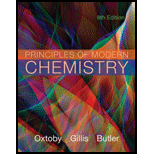
Principles of Modern Chemistry
8th Edition
ISBN: 9781305079113
Author: David W. Oxtoby, H. Pat Gillis, Laurie J. Butler
Publisher: Cengage Learning
expand_more
expand_more
format_list_bulleted
Concept explainers
Question
error_outline
This textbook solution is under construction.
Students have asked these similar questions
Please correct answer and don't used hand raiting
For each molecule below, predict whether the molecule would be expected to show aromatic character or
not. Explain your answer in each case. These molecule are planner. [THREE]
a.
b.
HIN:
(14) annulene
C.
OH
d.
:0:
:0:
+
Drawing Instructions: Draw structures corresponding to each of the given names.
a. Draw: 2-ethyl-1,3-butadiene
b. Name:
Knowledge Booster
Learn more about
Need a deep-dive on the concept behind this application? Look no further. Learn more about this topic, chemistry and related others by exploring similar questions and additional content below.Similar questions
- Please correct answer and don't used hand raitingarrow_forwardс. d. СнЗ Сизена=-4=4 Cla H Eget3 над f. e. H-C=C-CH3 + 285 → H-C=C-CH3+2не H-C=C-CH3 + Nanta» g+ CH₂ CH₂-G = G-C₁₂-G=CH₂ + 2HI→ H H H ALarrow_forwardThe IR (infrared) spectra of two pure compounds (0.010 M compound A in solvent and 0.010 M compound B in solvent) are given. The pathlength of the cell is 1.00 cm. The y-axis in the spectra is transmittance rather than absorption, so that the wavenumbers at which there is a dip in the curve correspond to absorption peaks. A mixture of A and B in unknown concentrations gave a percent transmittance of 49.8% at 2976 cm¹ and 44.9% at 3030 cm-1 Wavenumber 0.010 M A 0.010 M B Unknown 3030 cm-1 35.0% 93.0% 44.9% 2976 cm-¹ 76.0% 42.0% 49.8% What are the concentrations of A and B in the unknown sample? Transmittance (%) 100 90 80 70 60 50 40 2976 cm-1 30 3030 cm-1 20 Pure A 10 Pure B 0 3040 2990 Wavenumber (cm-1) 2940 2890arrow_forward
- synthesize 1-propyne starting with propane.arrow_forwardstarting reactant IV target + enantiomer 1) BH3, THF 2) H₂O2, NaOH, H₂O 1) Hg(OAc)2, THF, H₂O (or ROH) 2) NaBH4 D2, Pt/C H₂, Pt/C D2, Lindlar catalyst or Ni₂B H₂, Lindlar catalyst or Ni₂B NaNH, OH/H₂O or SH/H₂S H₂O/H₂O 1) 03 2) H₂O 1) 03 2) (CH3)2S HBr, w/ROOR HBr, (cold, dark, no ROOR) Naº, NH3(e) NBS (trace Br2), light HgSO4, H2SO4, H₂O Naº, ROH 1) Sia₂BH, THF 2) H2O2, NaOH, H₂O H3O/ROH or H₂O*/RSH OR/ROH or SR/RSH 1) OsO4, NMO 2) NaHSO3, H₂O 1) MCPBA (peroxy acid) 2) H3O, H2O (or ROH or RSH) KMnO4 (warm, concentrated) Br₂/H₂O Br₂, heat or light Br2, cold, dark, no peroxides (CH3)3CO(CH3)3COH ROH or RSH H₂O KMnO4/OH (cold, dilute)arrow_forwardNonearrow_forward
- Indicate whether the ability of atoms to associate with each other depends on electron affinity.arrow_forward1) Write the reduction half reactions and find the reduction potential for each pair.a. Zn/Zn2+b. Cu/Cu2+c. Al/Al3+d. Ag/Ag1+ 2) For each of the following voltaic cells, identify the anode, cathode, write the standard cell notation/diagram, and predict the cell potential.arrow_forwardThe following reaction is first order in NO2. Solve the differential rate equation to create the integrated rate law. NO2 (g) -> NO(g) + O (g)arrow_forward
arrow_back_ios
SEE MORE QUESTIONS
arrow_forward_ios
Recommended textbooks for you
 Chemistry & Chemical ReactivityChemistryISBN:9781337399074Author:John C. Kotz, Paul M. Treichel, John Townsend, David TreichelPublisher:Cengage Learning
Chemistry & Chemical ReactivityChemistryISBN:9781337399074Author:John C. Kotz, Paul M. Treichel, John Townsend, David TreichelPublisher:Cengage Learning General, Organic, and Biological ChemistryChemistryISBN:9781285853918Author:H. Stephen StokerPublisher:Cengage Learning
General, Organic, and Biological ChemistryChemistryISBN:9781285853918Author:H. Stephen StokerPublisher:Cengage Learning Chemistry: The Molecular ScienceChemistryISBN:9781285199047Author:John W. Moore, Conrad L. StanitskiPublisher:Cengage Learning
Chemistry: The Molecular ScienceChemistryISBN:9781285199047Author:John W. Moore, Conrad L. StanitskiPublisher:Cengage Learning Chemistry: An Atoms First ApproachChemistryISBN:9781305079243Author:Steven S. Zumdahl, Susan A. ZumdahlPublisher:Cengage Learning
Chemistry: An Atoms First ApproachChemistryISBN:9781305079243Author:Steven S. Zumdahl, Susan A. ZumdahlPublisher:Cengage Learning Chemistry: Principles and PracticeChemistryISBN:9780534420123Author:Daniel L. Reger, Scott R. Goode, David W. Ball, Edward MercerPublisher:Cengage Learning
Chemistry: Principles and PracticeChemistryISBN:9780534420123Author:Daniel L. Reger, Scott R. Goode, David W. Ball, Edward MercerPublisher:Cengage Learning Chemistry & Chemical ReactivityChemistryISBN:9781133949640Author:John C. Kotz, Paul M. Treichel, John Townsend, David TreichelPublisher:Cengage Learning
Chemistry & Chemical ReactivityChemistryISBN:9781133949640Author:John C. Kotz, Paul M. Treichel, John Townsend, David TreichelPublisher:Cengage Learning

Chemistry & Chemical Reactivity
Chemistry
ISBN:9781337399074
Author:John C. Kotz, Paul M. Treichel, John Townsend, David Treichel
Publisher:Cengage Learning

General, Organic, and Biological Chemistry
Chemistry
ISBN:9781285853918
Author:H. Stephen Stoker
Publisher:Cengage Learning

Chemistry: The Molecular Science
Chemistry
ISBN:9781285199047
Author:John W. Moore, Conrad L. Stanitski
Publisher:Cengage Learning

Chemistry: An Atoms First Approach
Chemistry
ISBN:9781305079243
Author:Steven S. Zumdahl, Susan A. Zumdahl
Publisher:Cengage Learning

Chemistry: Principles and Practice
Chemistry
ISBN:9780534420123
Author:Daniel L. Reger, Scott R. Goode, David W. Ball, Edward Mercer
Publisher:Cengage Learning

Chemistry & Chemical Reactivity
Chemistry
ISBN:9781133949640
Author:John C. Kotz, Paul M. Treichel, John Townsend, David Treichel
Publisher:Cengage Learning
Solutions: Crash Course Chemistry #27; Author: Crash Course;https://www.youtube.com/watch?v=9h2f1Bjr0p4;License: Standard YouTube License, CC-BY